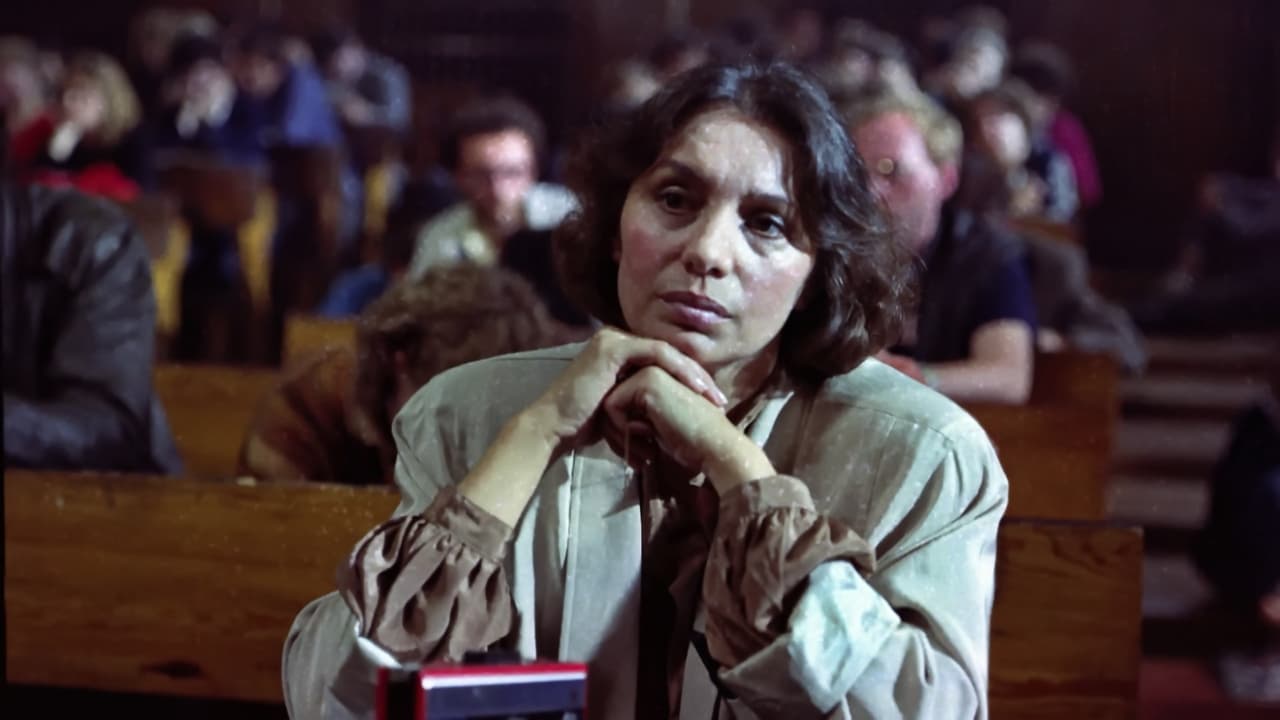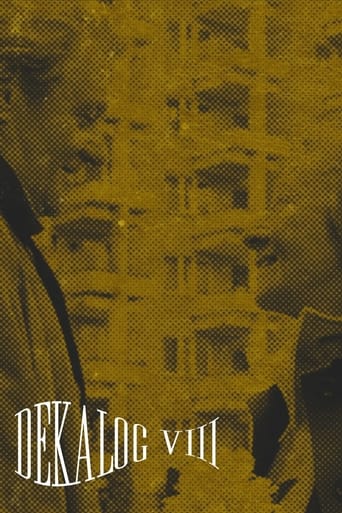

This is not a particularly remarkable Dekalog. But it's simple and lays out as clearly as any of them the blueprint that Kieslowski worked towards, both in these 10 Dekalogs, the longer short films, and it remains to be seen I guess if he perfects and evolves this for the color trilogy.The twofold blueprint is that we have a world and a story that takes place. The world across the 10 Dekalogs is the same few months in the life of an apartment block, ostensibly the same few months the show aired. Here for example we have the story of Dekalog 2 with the dying husband laid through as something that happened in the same neighborhood.Anyway this world is open-ended and ebbs forward and back with what the protagonists have set in motion around them. The most interesting thing about Dekalog is Kieslowski's ability, snippets of it in TV form, to render that visually as movements in emotional air.The story each time focuses on a moral issue, here it's guilt, tied to the Polish experience of WWII and how it reverberates still. But time and again the story is reduced to two characters forlornly baring themselves to each other in a room, explaining or avoiding to. Bergman.Here we have it clearly: the notion (during a class on ethics) of stories where readers (viewers) have to surmise the motivation of characters. One of these viewers inside the class begins narrating her own story that begs for ethical interpretation: a Jewish girl in need of shelter from Nazi horror who was turned away from a Catholic Polish home.Kieslowski attempts to visually inhabit a corner of this story (no more is allowed by the TV format): the old woman returns to the same WWII home where the story took place, the girl is lost and she looks for her distraught. She was the protagonist in that story, now inhabiting the memory of it.Then we are back in a room where we have a deeper story that explains the former, giving us a plausible ethics that explain what seemed like wrongdoing at the time. This is the same Dekalog effort of setting up a story that they try to deepen later on with more complicated morals. The idea is that we leave these Dekalogs with some insight into the destructiveness of what it means to inhabit a story (the Jewish girl carried that story of wrongdoing with her for 40 years) as well as some measure of realization about the complexity of inter-dependence forces at work behind the stories.But this is too clear, a template on how to write rather than a poem.
... View More"Simuland" him/herself bears false witness by spreading ignorance!: "What Polish underground? That must have been a really exclusive minority. There was no organized effort by any Polish underground to save Jews; whatever Jews happened to be rescued were done so by individuals acting on their own. To claim otherwise, as K. does, is to lie." FACT: Poland had the largest--and longest lived--underground in Europe during WWII! It gave France & Britain a copy of the Germans' enigma coding machine, & helped to crack the code. FACT: Future Georgetown University Jan Karski escaped to England to inform a doubting West of the Holocaust(including meetings with British foreign secretary Anthony Eden and President Franklin D. Roosevelt). FACT: Zegota (the Council to Aid Jews)was a branch of the Polish underground established to rescue Jews from the Nazis.Its express purpose was to aid the country's Jews and find places of safety for them in occupied Poland. Poland was the only country in occupied Europe with such a dedicated secret organization.Simuland then continues to spew his bigotry: "Widespread deep-seated Polish anti-Semitism both predated and survived the Nazi invasion; Poles killed Jews even after the Nazi's retreated. To this day they make life insufferable for the scarce Jews who remain in their country. (I have this directly from a Jewish colleague who grew up in and fled modern Communist Poland.)" There was strong animosity on both sides toward each other. This came from centuries of antagonistic living in close quarters (predicated by Poland's unprecedented religious tolerance--which is why 90% of European Jews lived autonomously in pre-partitioned Poland). While some Poles did kill Jews, it is likewise true that some Jews killed Poles. To blame the entire populations for the actions of the few, would be like blaming all Americans for the actions of the Ku Klux Klan. Many Jews were communists (the 1st. head of the party in post-war Poland, for example), and helped the Soviets to select & deport 2 million Poles to Siberia after Stalin invaded & divided the country with his ally, Hitler, in 1939 (within a year, 1 million of these Poles were dead). The "pogrom" he alludes was political. In the Cold War, Moscow backed the Arabs against the U.S. backed Israel. It directed the Polish Communist Party to rid itself of its Jewish faction. The non-Jewish & Jewish factions of the party were bitter rivals.
... View MoreDekalog 8 introduces a debate about a situation described in the second episode of the series, with regard to some interesting researches about thematic morals made in an unadorned lecture hall. As in a game of mirrors, Kieslowski's magical poetry proposes subtle allusions, references, previous solutions analysed under different points of view.The analysis of Elzbieta's personal story framed within the context of her restless past and recalled in the light of her present time made of painful and unavoidable confrontations proposes the harassing thought about our duty to God, about our moral obligations towards the Christian commandment, "Thou shalt not bear false witness against thy neighbour". Is it possible to be merciful to our fellowmen even at the risk of violating the dictates of divine commandments? Are we allowed to help people even if we are aware about the incompatibility between the ethical principles applied to the evidences of religion and the intention of "bearing false witness against our neighbour" to a good purpose? Is it really possible to give up the idea of getting out of the clutches of the Nazi police a six-year-old Jewish child in the desperate need of a certificate of baptism only on account of moral and religious scruples? The dramatic explanation between Elzbieta, haunted by the memories of her unhappy childhood, and Zofia, the elder woman who refused to give her a passport to safety many years ago, call to our minds a sense of bewilderment and affliction.Both of them are afraid of something going up in smoke around them and nothing escapes their remembrances of a painful past. Sad remembrances of course, because nothing hurts like the truth. Crude in the same manner as a vivisection of the soul. Conjured up with surgical precision in the coldness of an utterly impersonal ambient. Maybe only a cathartic face to face between the two women would give life to new friendly relations made of comprehension, explanations, reconciliations. Kieslowski divides all humanity into two parts: the saviors and the saved. His strict dialectics traces all the uneven steps of the story in a very subtle way. He likes to give back to human dignity its state of primitive and natural innocence, deeply upset by a pressing sense of misinterpreted obedience to the precepts of the Church.
... View MoreWith a minimum of histrionics, this film tells a simple story about the legacy of the holocaust in Poland.A college professor who once turned away a little Jewish girl who sought refuge is confronted by that same girl -- now in her forties -- and must explain to her the real reason for turning her away. While the two women are able to forge a deep friendship, the man (a tailor) who risked his life to try and save the girl has become, with time, too closed off to allow her to form any sort of bond with him. The film's last image, of the lonely tailor looking out the window of his shop to see the professor and her friend laughing together, has the same straight forward and unassuming emotional wallop that ends many of Kieslowski's films.This may be the best fictional film ever made about the holocaust.
... View More